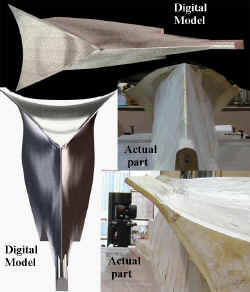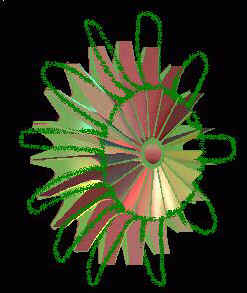Reverse Engineering
Introduction….
What is reverse engineering? Reverse engineering or “RE”, is a process of digitizing an object in the real world, and taking it into the digital world. If you ever saw the1982 science fiction movie “TRON“, this was the concept that was depicted when Jeff Bridges was zapped with a giant laser and sucked into the mainframe computer, and forced to play lethal video games.( with the typical Hollywood exaggerations, of course). We may shoot out parts with lasers, but we leave them in the real world, and “copy” them into the virtual one. Once parts are in the virtual world, we have the ability to easily modify, test, assemble and perfectly mass re-produce them by use of CAD/CAM/CAE software and CNC machining or 3-D printing, also known as rapid prototyping. This marriage of technologies has had a considerable impact on bringing existing parts and the associated equipment that supports them into the 21st century.
There are many reasons to bring parts into the virtual world, besides the obvious advantages in reproducing them. One of the main reasons is to preserve the value of all the previous effort that went into designing, testing, and building them. There are basically two ways to preserve that value. One, try to somehow store the item in a secure and compatible place, but often that would require more effort and cost than the part itself, and natural degradation of the material may still ruin the part. Two, is to copy the essence of the part into the digital world where you can keep it forever, easily copy and share it if you like, modify, or make a new one any time you wish. We can put an entire warehouse of parts on one CD / DVD Rom, and take it anywhere in a coat pocket or briefcase. Hand carry able, portable warehouses, what a concept! With the rate that technology is moving, you’ll soon be able to take your portable warehouse to the replicator, pop in your disk, select the part and quantity needed, and presto, out come the parts. Gotta love that! 😉
Top of page
Aerospace Reverse Engineering….
The aerospace industry has one of the largest needs for this technology. There are literally hundreds of thousands of parts that were designed and hand crafted before the inception of CAD or CNC machines. Many of these parts are still in high demand as the air vehicles that they are used in are still in service around the world. In most cases, the replacement and repair parts that are required, must still be made in the same time consuming manner as they were years ago. This amount of time and effort is extremely expensive with the current labor costs, not to mention the large amount of expensive hard tooling that is required, to maintain some amount of quality and consistency in the parts. Getting these programs shifted over to modern production technologies previously involved basically starting over with the engineering and CAD drafting teams. This of course, is not cost effective. There needed to be a bridge between the old and new methodology that would not be such a huge undertaking. There had to be a way to save the thousands of man-hours of engineering and testing time that was already invested into these programs, this is where RE rises to the challenge.
Specific links to aerospace case studies:
 | Plaster Disaster to Digital Master- Aft Pylon Fairing Come with us as we take an engineering authority plaster master tool that has been very badly damaged and is starting to deteriorate, and make a digital CAD model, to not only verify how well it was made to the engineering Mylar drawings that it was created from, but allow a new one to be modified and manufactured at a later date if needed. Click on the picture to enlarge….. |
Industrial Reverse Engineering….
The industrial side of reverse engineering has almost no boundries to the needs and applications in the marketplace. These can range from small intricate parts like in ear hearing aides, to massive structures such as bridges and even entire industrial plant sites. This large range of applications also often demands much higher accuracy than some of the more artistic oriented fields that also use reverse engineering to preserve or reproduce complex organic shapes from ornamental railings to fountains and sculptures. The intrinsic need for exact replication of machined, tight tolerance parts cannot just follow a single process or methodology, there must be a good deal of thought placed into the project long before the actual data collection can begin. In many, if not most cases there is wear or damage to the parts needing replication, therefore if you simply reproduce the sample, the result would likely be an unusable or inadequate part. Knowing the form, fit, or function of the item will enable us to avoid collection of data in worn or damaged areas, and use other actual or nominal engineering data to “fill in” the missing data, and end up with a part that meets or often exceeds the quality of the original. A good example of this “filling in” of data is explained in the case study of ahigh speed centrifugal compressor wheel.
| Industrial Reverse Engineering Case studies:High speed centrifugal compressor wheel A highly effective practice for replacing the bad sections of a part digitally, is to use the mating surface of an exsisting part or a new unworn part, to establish the correct geometry when replicating a worn or damaged part. This process has also been termed “profile match machining”. Click on the photo to view this case study |  |